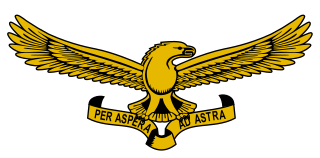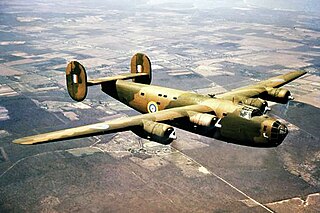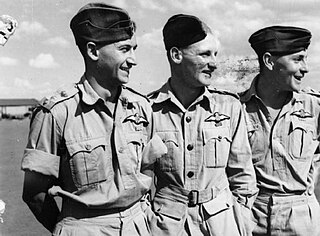Related Research Articles

The South African Air Force (SAAF) is the air warfare branch of South African National Defence Force, with its headquarters in Pretoria. The South African Air Force was established on 1 February 1920. The Air Force saw service in World War II and the Korean War. From 1966, the SAAF was involved in providing infantry support in the low-intensity Border War in Angola, South-West Africa and Rhodesia. As the war progressed, the intensity of air operations increased, until in the late 1980s when the SAAF were compelled to fly fighter missions against Angolan aircraft in order to maintain tactical air superiority. On conclusion of the Border War in 1990, aircraft numbers were severely reduced due to economic pressures as well as the cessation of hostilities with neighbouring states.

2 Squadron is a squadron in the South African Air Force which was formed in 1940. The squadron has a long history, having been involved in every single combat action in which the SAAF has taken part. During the Second World War it made a name for itself in the battles for East Africa, before distinguishing itself in North Africa as part of the Desert Air Force, and later in Italy.

1 Squadron SAAF was an air force squadron of the South African Air Force and was formed at Air Force Station Swartkop in February 1920, equipped with De Havilland DH.9s part of the Imperial Gift donation to South Africa by Britain. On 31 August 1939 the squadron was re-designated as 1 Bomber/Fighter Squadron and this was then changed to 11 (Bomber) Squadron in December 1939. The squadron was resurrected in February 1940 by the renumbering of 6 Squadron, equipped with four Hurricane Mk 1s and six Furies.

Hans-Arnold Stahlschmidt was a German fighter pilot during World War II. A flying ace, he was credited with 59 victories against the Western Allies in North Africa. Stahlschmidt was a close friend of the prominent ace Hans-Joachim Marseille.

John Everitt Frost, was a South African fighter ace during the Second World War. He was the highest-scoring member of a South African Air Force squadron during the war, credited with the destruction of 15 Axis aircraft. South African pilots with higher numbers of kills, such as Pat Pattle and Adolph "Sailor" Malan, were members of the British Royal Air Force.

5 Squadron SAAF was a South African Air Force Fighter / Fighter-Bomber squadron during World War II. It was disbanded at the end of the war and was re-commissioned in 1950. It remained active until 2 October 1992, when it was disbanded; its Atlas Cheetah E aircraft were also decommissioned.

7 Squadron was a unit of the South African Air Force which served in the Second World War as well as in South Africa between 1951 and 1992. During the war, the squadron was used as a fighter squadron deployed to the Western Desert as well as in the Aegean, Italy and Ceylon. The squadron was inactive from the end of the war until 1951 when it re-activated as a citizen force training squadron, a role it retained during two periods of active service until 1992, when it was disbanded for the last time.

31 Squadron was initially a World War II Coastal bomber/reconnaissance squadron South African Air Force. It was later converted to a heavy bomber squadron that operated from bases in the Mediterranean from January 1944 until the end of the war. On conclusion of hostilities, the squadron was used to ferry liberated POW's from Italy back to Britain and disbanded South African troops from Italy to Egypt. It was disbanded on 15 December 1945. It was resurrected as a medium and light helicopter squadron in 1982 and operated from AFB Hoedspruit until its final disbandment on 4 December 1992.
The History of the South African Air Force spans the First World War, Rand Rebellion of 1922, the Second World War, the Korean War, the South African Border War, and varied peacekeeping operations since 1994. Its battle honours include German South West Africa 1914–15, German East Africa 1915–1918, East Africa: 1939–1941, Middle East: 1941–43, Madagascar 1942, Italy 1943–1945, the Balkans 1943–1945, and Korea 1950–1953.
Andrew Bosman was a South African flying ace of World War II, credited with shooting down at least eight aircraft. He was killed in a postwar flying accident.
Peter Metelerkamp was a South African flying ace of World War II, credited with 5 'kills'.
Robert Talbot (1916-1941) was a South African flying ace of World War II, credited with 10 'kills'.

Robin Pare was a South African flying ace of World War II, credited with five 'kills'.

Servaas van Breda Theron was a South African World War II fighter ace, credited with 10 'kills'.

Laurence 'Laurie' Wilmot was a South African flying ace of World War II, credited with 4 'kills'.

Gerald John Le Mesurier (1914-1943) was a South African flying ace of World War II, credited with 3 'kills'.

Douglas William Golding is a South African flying ace of World War II, credited with 3 'kills'.
Eric Cowley Saville (1922-1943) was a South African flying ace of World War II, credited with 8 'kills'.

Brian John Lister Boyle, DFC (1917-1993) was a South African flying ace of World War II, credited with 5 'kills'.
Douglas Haig Loftus (1917-1991) was a South African flying ace of World War II, credited with 4 'kills' and 1 shared.